
554.
That’s how much monthly website traffic we had to our website three months ago.
20 visitors a day may sound encouraging if you’re starting a personal project, but when your goal is to build a successful business with a team counting on you…
Well, you’re probably screwed.
And if we continued at that pace, we would’ve been. So what did we do?
After a few minutes of panic, we got down to reality, and started experimenting with any possible source of traffic to our website. A lot of it failed (in fact, most did).
But some of them worked.
A few worked well enough to get us from 554 visitors/mo to 25,500+ visitors/mo (5,000 percent+ increase) in just three months.
And this is what we’re here to share with you today.
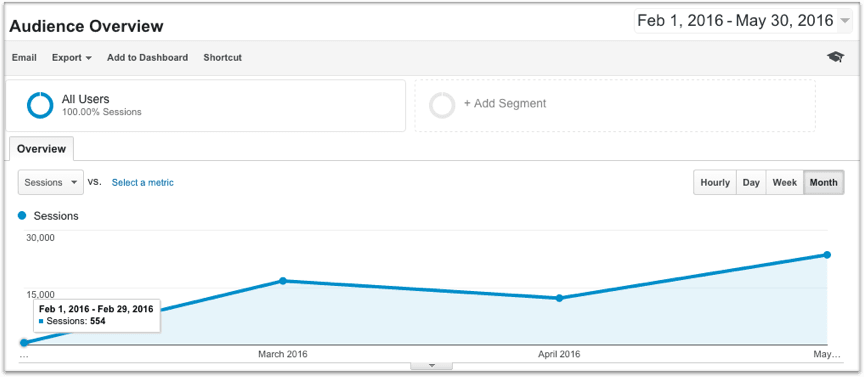
Starting out: Modeling the best
Before we set out on our own experiments, we wanted to study and model the best online marketers and companies that have demonstrated success in their marketing.
Getting traffic to your website is not a magic wheel that needs to be reinvented, and we knew modeling the best experts can help us shorten the learning curve.
The top companies and influencers we focused on were Buffer, Neil Patel, Moz, Groove, and First Round Review. Each of these brands have their own unique way of sharing their story, but they’ve all built massive businesses around it. I’m a customer or an ambassador for all of these brands, not so much because of their product, but because of their story.
So when we broke it down, all of them had a content marketing strategy that had 3 traits in common:
- Value first: At the core of everything these companies shared, it was focused on giving value first. From every blog post, interview, or social media post, they truly cared about helping their audience, which is something few brands can pull off.
- Transparency: Moz and Buffer were pioneers in placing public transparency as one of their core values, and actually putting into action. Buffer releases their salaries, equity, revenue, and pretty much everything you can imagine out to the public, and it has become one of our core values as well.
- Consistency: We have a long way to go with this since we’re just starting out, but these brands have been at this for many years putting out valuable content consistently every week.
Sure, there’s more to explaining the success of these brands than just these 3 traits. But we wanted to focus on doing these three really well, and knew the rest will follow.
After taking all of these factors into account, the following channels helped us increase our website’s traffic by 5,000 percent + in three months.
1. Blogging
Our blog (the one you’re reading now) didn’t have a glamorous start.
We didn’t have a massive launch, nor a big uptake in website traffic in the first few months of getting started. I felt a similar feeling of impatience when I started my personal blog, so I prepared myself for the long journey ahead.
What helped ground me the most was reading the stories of successful founders, who were in the same boat as we were when they first started. A great story I want to share with you is the story of Unbounce.
With only $850,000 in funding in 2011, the company did $12.5M in revenues for 2015. And before that funding, they bootstrapped.
How did they reach this success without spending millions of dollars on advertising? Sure, they had a great product. But according to their CEO, Rick Perreault, it came down to creating amazing content for their audience from day one.
“The Question We Had From The Beginning Was ‘How Are We Going To Find Customers? People Didn’t Even Know To Look For Us, So How Will We Go Out And Find Them?
So That Was A Really Important Challenge For Us To Tackle, And We Made The Decision To Start Blogging On Day One.”
-Rick Perreault, CEO Of Unbounce.Com
And we hear this strategy over and over again from companies.
Getting featured on top media outlets is great, but it’s an unsustainable source of traffic. And for companies like Buffer, it wasn’t even possible.
In an interview, Buffer’s Co-founder Leo stated that: “They pitched Buffer to top tech blogs like TechCrunch and Mashable, but nobody wanted to write about them, even blogs with smaller audiences.”
This is when Buffer’s blog was born, which now attracts millions of visitors per month.
Scaling your content reach
More importantly, Leo’s big breakthrough came when he heard Rand Fishkin, founder ofMoz.com, explain the secret to scaling your content:
Instead of creating your content for potential customers, Fishkin advocated, create it for influencers who are already reaching them.
We took this to heart, and started writing posts that influencers in our industry (i.e. language bloggers, personal development influencers) would enjoy.
In fact, our two best performing blog posts: ‘What are the most useful languages to learn?‘ and ‘How to re-learn a language you’ve forgotten‘ can be directly attributed to writing for influencers that reach our target audiences.

Takeaway
Building up an audience for your blog takes time. The earlier you create a strategy and start bringing value to your potential customers, the better. Google even has a six month sandbox, where new domains are on ‘probation’ in order to prevent spam websites from popping up. This is an even bigger reason to start as soon as possible.
Today, our blog is doing just under 23,000 unique visitors per month. It’s not a lot, but we are growing fast, and I’m confident we can hit 50,000+ by the end of this year.

Building up your blog’s traffic has the same powerful effect that investing has — compounded growth. This means that while you’re not seeing huge gains in the beginning, your traffic starts compounding over time, and you’re able to see a big return.

2. Guest blogging
Guest posting on other publications or blogs can be even more powerful for building up your traffic, because you’re leveraging other people’s audience.
I can attribute most of our early traffic growth to writing for publications that reach our target audience, including Lifehack, The Next Web, Fast Company, and more. Some of these posts were syndicated from our blog, while others have been original content we wrote.

I often get asked by fellow entrepreneurs how we’ve managed to get featured on these different publications, and I respond with the same answers every time – valuable content, relationship, and time.
In other words, there’s no magic bullet here.
It took us over a year to build up a portfolio of great content, in order to leverage it to get on other publications. Even when we had the relationship in place, it still took a ton of time to write, refine, and follow-up to get even one guest post up.
Before you start reaching out to editors of larger publications, crafting the right email is important. You want to share your credibility (i.e. track record, other publications you’ve written for), what topics you focus on, and examples of your previous writing. I recommend doing this in one email, so you avoid going back and forth with the editors.
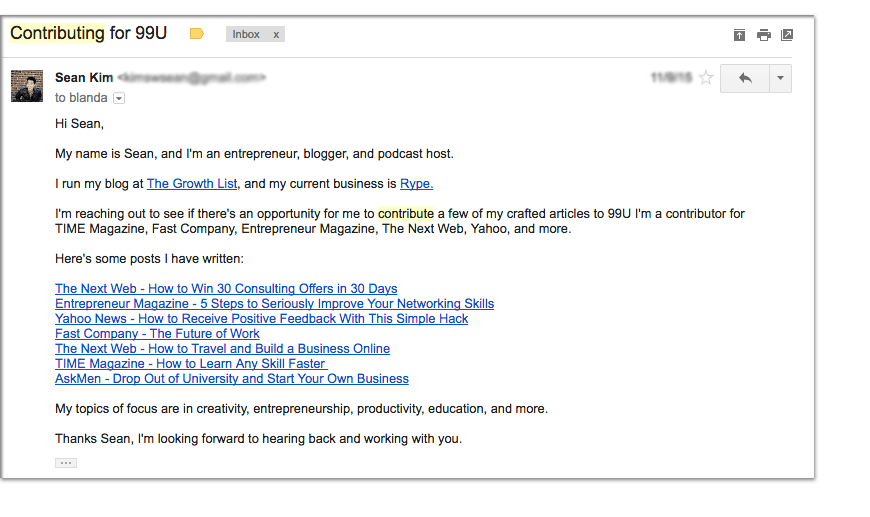
While our attention is going more towards building up our own blog, guest blogging will always be in our future growth plans, as it’s one of the cheapest and fastest ways to scale your growth.
3. Side projects
Side projects, as long as it’s not time consuming and focused with an objective, is always a good idea. I remember speaking with Mikael from Crew, when he mentioned that side projects basically saved their startup.
In fact, one of their side projects, Unsplash, which Mikael created himself, is the number one source of traffic to Crew today.
“We Had No Money.
We Changed Our Business Model And Had 3 Months Worth Of Cash Left To Turn Things Around. If We Didn’t We Were Toast. Done.
We Needed To Find Customers. But No One Knew Who We Were.
A Marketing Budget? Please. We Were Just Trying To Keep The Lights On.”
-Mikael Cho, CEO Of Crew
As a bootstrapped company, we also knew that we had to get creative with side projects to ‘keep the lights on.’
Many of them, including our ‘Travel The World’ or our ‘Vote for the Best Coach’ competitions never really took off. But we managed to have one success: our Learn a Language Challenge, which quickly got around the language learning community.
Not only did it help drive awareness to our brand, we gathered over 2,000+ highly targeted leads in less than a month (from April to May).
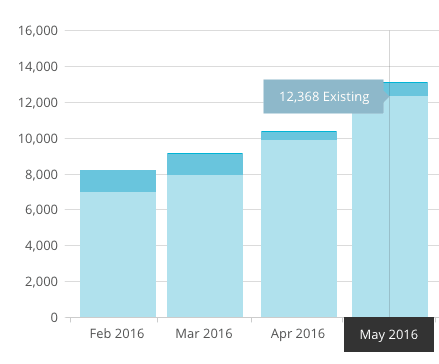
4. SEO/organic search
SEO was something that we didn’t focus on in the beginning. We had a basic idea of optimizing our blog content for certain keywords, but it wasn’t a top priority.
It wasn’t until more and more customers were telling us they found us by searching online, that we got serious with optimizing for certain keywords.
There’s no magic formula to the way we optimize for SEO, but we do look for Low Competition keywords with at least 1,000 average monthly searches to give us the best chance of ranking for them.
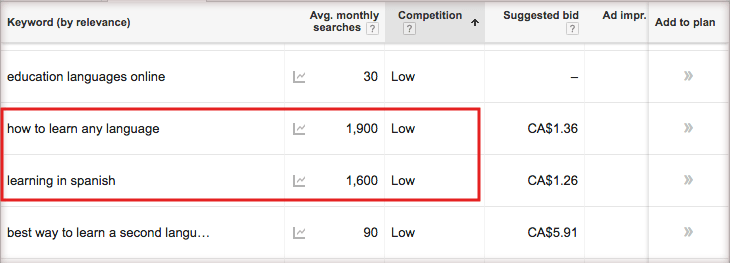
If you’re new to SEO, we recommend checking out Moz’s Beginner’s Guide to SEO.
5. Influencer reachout
We saved this last point for last, because it’s one that we’re probably under leveraging.
There’s a couple of reasons for this:
1. Unlike the health/fitness, marketing, or cosmetic industry, there’s not a plethora of major influencers that reach a mass audience in our industry.
2. With limited resources, we wanted to avoid stretching ourselves too thin, in order to maximize on what’s already working.
Nonetheless, partnering up with influencers gives you more than just direct traffic to your brand.
It gives you credibility.
At the moment, we only couple this strategy with our blog promotions by reaching out to influencers we already know. But as we bring in the necessary resources, this is a channel we’ll invest heavily into very soon,

How to apply this to your business
As you can see from our breakdown chart below, most of the tried-and-true methods that were successful for certain businesses had absolutely no impact on ours. But we would have never known this, unless we tried it ourselves.
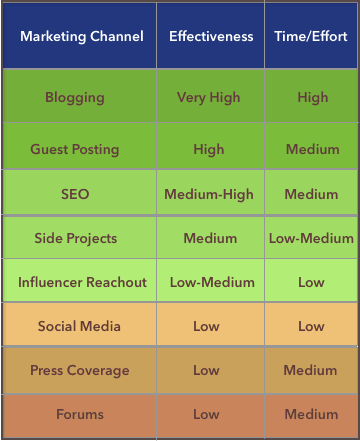
There will always be experts and gurus that will tell you that “podcasting” is the new hot thing, or how if you’re not on “Snapchat”, you’re missing out. The truth is, unless they know just as much about your business, vision, and customers as you do, you should be careful to follow their advice.
Every business is different. What worked for our business may or may not work for yours.
What we can tell you is that the approach we used to arrive at successful channels for our business, can be applied to yours. It’s called the ‘Bullets before Cannons’ approach that was popularized by Jim Collins, the bestselling author of Good to Great.
Bullets are “low risk, low cost, low distraction tests that can lead to a great opportunity.” They’re tiny experiments that you can spend implementing (10-20% of your time and effort), while nurturing what’s already working for you. This can be a targeting a new customer segment, new Facebook campaign, new landing page experiment, etc.
Shooting Cannon balls is when you double down on proven channels after firing several tiny bullets. This is where you can see exponential returns.
I hope the strategies in this post gave you a fresh perspective on growing your own website, project, and business. I’d love to know: what are some of the website traffic strategies that are working for you?
Get the TNW newsletter
Get the most important tech news in your inbox each week.




